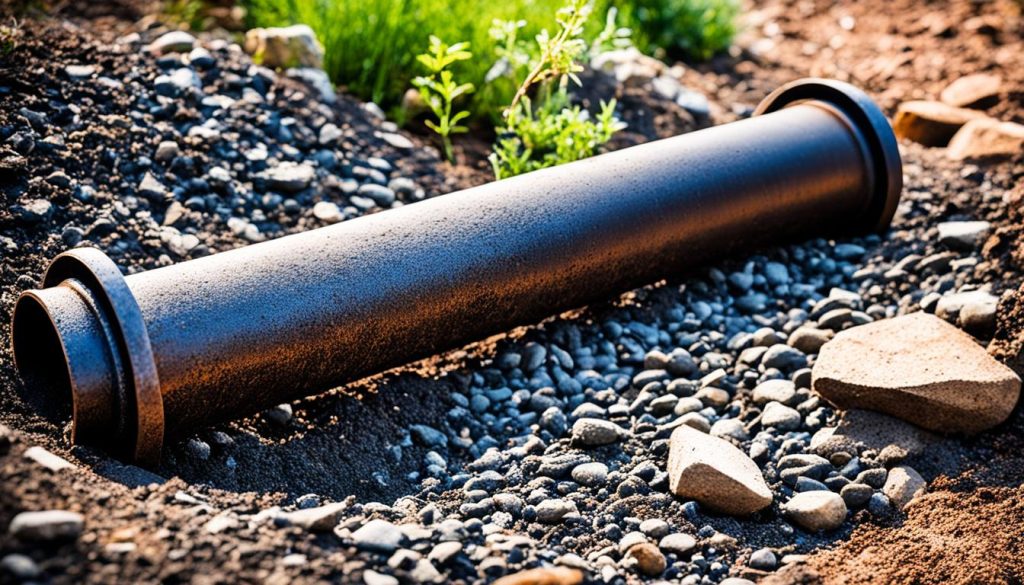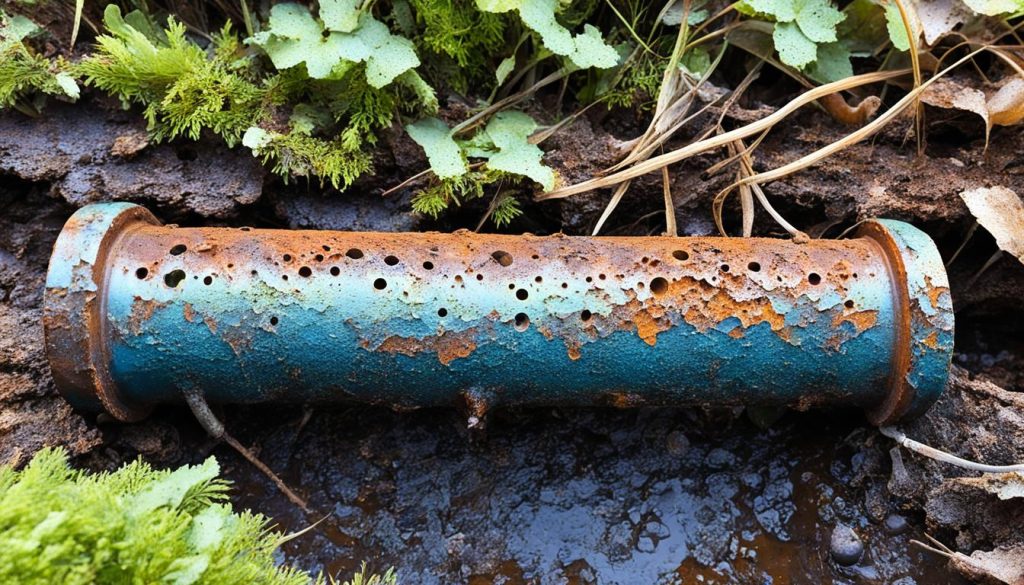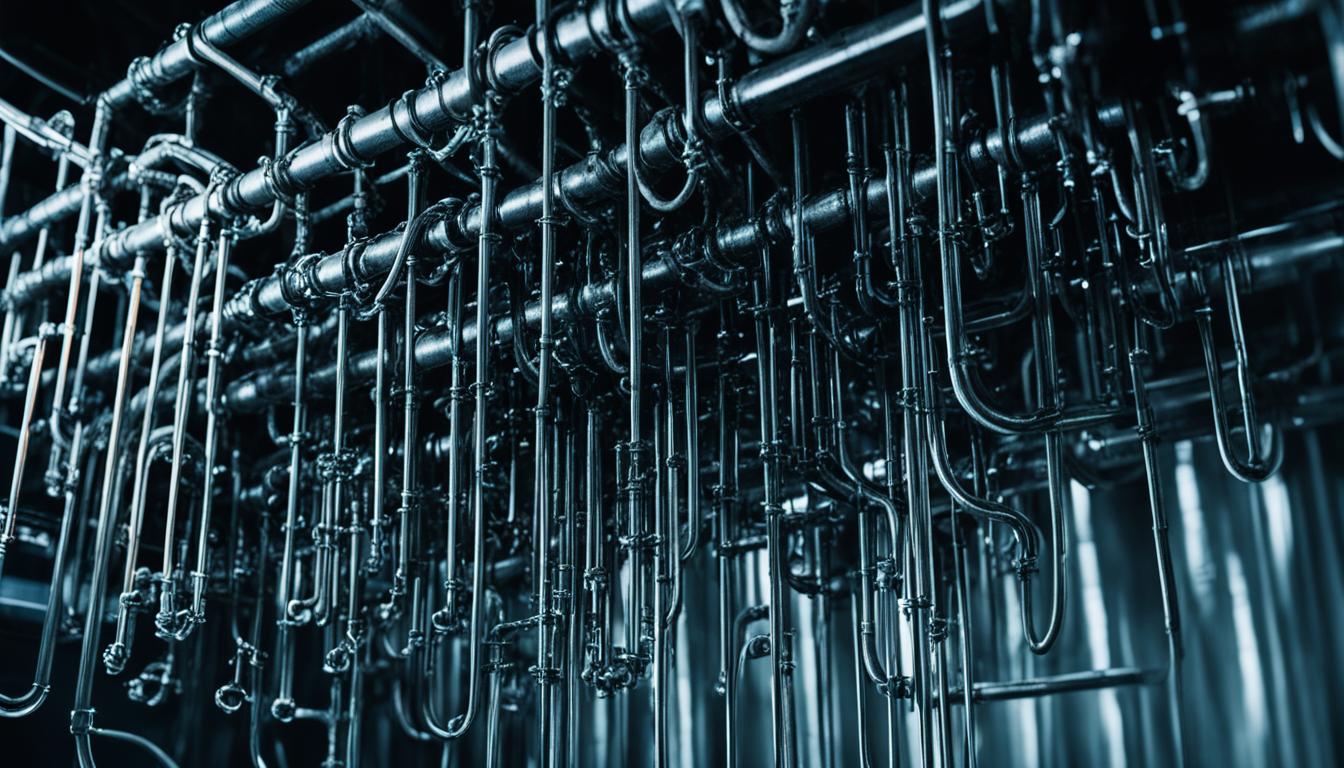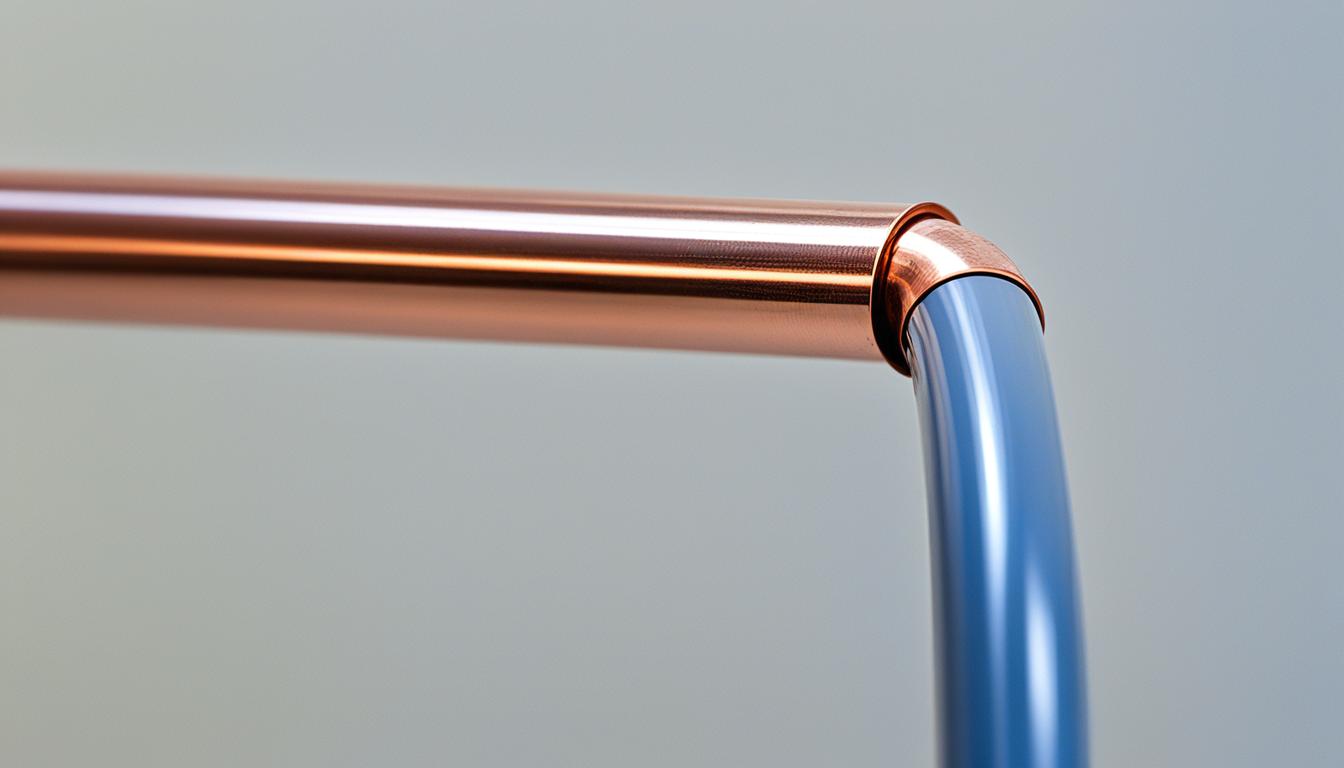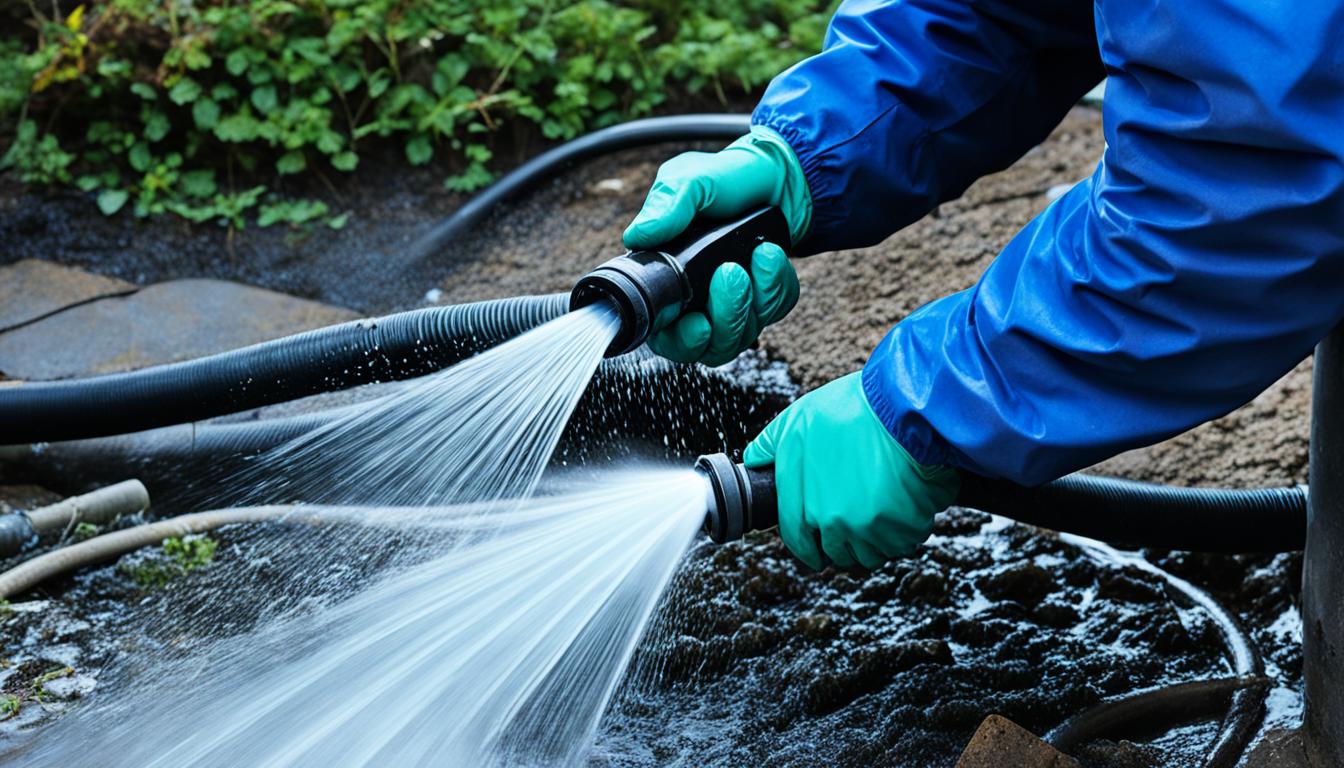Cast Iron Pipe Durability and Uses Guide
Did you know that over 95% of cast iron pipes installed underground in the US are still functioning after many years of service? That’s right! Cast iron pipes have been a staple in plumbing systems for centuries due to their exceptional durability and resistance to corrosion. These vintage cast iron pipes have stood the test of time, providing reliable plumbing solutions even in the harshest conditions.
Key Takeaways:
- Cast iron pipes have excellent durability and resistance to corrosion.
- They can withstand temperature extremes, traffic, and trench loads.
- Over 95% of cast iron pipes installed underground in the US are still functional.
- Cast iron pipes meet all the necessary requirements for a safe and durable plumbing system.
- Vintage cast iron pipes showcase the enduring quality of this plumbing material.
The Benefits of Cast Iron Pipe Fittings
When it comes to plumbing systems, cast iron pipe fittings offer a range of advantages. These fittings are specifically designed to work seamlessly with cast iron pipes, providing secure connections that resist infiltration and exfiltration. The compatibility of cast iron pipe fittings ensures a reliable and leak-free plumbing system.
One of the key benefits of using cast iron pipe fittings is their durability. Made from high-quality cast iron material, these fittings are built to last. They can withstand the test of time and maintain the integrity of the overall plumbing system, even in demanding environments.
In the unfortunate event of damage or leaks, cast iron pipe repair is relatively straightforward. Instead of replacing the entire pipe, sections of the damaged pipe can be easily replaced with new cast iron pipe fittings. This cost-effective repair method saves time and resources while ensuring the continuity of the plumbing system.
To highlight the advantages of cast iron pipe fittings, here are some key points:
- Compatible with cast iron pipes
- Secure connections that resist infiltration and exfiltration
- Durable and long-lasting
- Straightforward repair process
By utilizing cast iron pipe fittings in plumbing systems, you can enjoy the benefits of a reliable and efficient system that stands the test of time.
Image: Cast Iron Pipe Fittings
Caption: Cast iron pipe fittings provide secure connections and durability for plumbing systems.
Installation and Maintenance of Cast Iron Pipes
Proper installation is crucial for the performance and longevity of cast iron pipes. When installing cast iron pipes, it is important to follow the manufacturer’s guidelines to ensure proper alignment and secure connections. This helps to prevent leaks and maintain the integrity of the plumbing system.
During the installation process, it may be necessary to cut cast iron pipes to the desired lengths. However, cutting cast iron pipe requires special techniques due to its strength and durability. It is crucial to use appropriate tools and techniques to ensure smooth and accurate cuts.
How to Cut Cast Iron Pipe
Cutting cast iron pipe can be challenging, but with the right approach, it can be done effectively. Follow these steps to cut cast iron pipe:
- Mark the pipe: Use a marker to indicate the exact location where you want to make the cut.
- Secure the pipe: Use a vise or clamp to secure the cast iron pipe in place, ensuring it does not move during the cutting process.
- Choose the cutting method: There are different methods to cut cast iron pipe such as using a snap cutter, reciprocating saw, or a diamond blade grinder. Choose the method that suits your needs and equipment availability.
- Make the cut: Carefully follow the instructions for the selected cutting method to make a clean and accurate cut. Take necessary safety precautions, such as wearing protective goggles and gloves.
- Remove burrs: After cutting the pipe, use a file or a deburring tool to remove any burrs or sharp edges.
Remember to always exercise caution and follow appropriate safety measures when working with cast iron pipes.
Regular Maintenance
Proper maintenance is essential to ensure the longevity of cast iron pipes. Here are some tips for maintaining cast iron pipes:
- Inspect regularly: Periodically inspect your cast iron pipes for signs of damage, corrosion, or leaks. Early detection can help prevent further issues.
- Clear blockages: If you encounter blockages in your cast iron pipes, use appropriate methods such as snaking or hydro jetting to clear them.
- Address repairs promptly: If you notice any leaks or damage, it is important to address them promptly. Repair sections of the pipe using compatible cast iron pipe fittings to maintain the overall system’s integrity.
- Consider professional help: Some maintenance tasks, such as extensive repairs or replacements, may require the expertise of a professional plumber.
By following proper installation practices and implementing regular maintenance, you can ensure the optimal performance and longevity of your cast iron pipe system.
Pros and Cons of Cast Iron Pipe Installation
| Pros of Cast Iron Pipe Installation | Cons of Cast Iron Pipe Installation |
|---|---|
| – Durability and long lifespan | – Heavy and difficult to handle |
| – Excellent noise suppression | – Requires professional installation |
| – Fire resistance | – Subject to corrosion in certain environments |
| – Suitable for high-temperature and high-pressure applications | – Higher cost compared to some alternative materials |
| – Compliant with various plumbing codes and regulations | – Limited availability of fittings and specialized tools |
Comparing Cast Iron Pipe to PVC Pipe
When it comes to plumbing systems, there are two popular choices to consider: cast iron pipe and PVC (polyvinyl chloride) pipe. While cast iron pipe has been the traditional option for many years, PVC pipe has gained significant popularity in recent times. Let’s explore the characteristics and benefits of each to determine which one might be the best fit for your plumbing needs.
Cast Iron Soil Pipe
Cast iron soil pipes are renowned for their exceptional durability and robustness. They are highly resistant to abrasion, making them suitable for handling heavy-duty tasks. These pipes also offer excellent noise suppression, minimizing any clattering sounds that may occur during water flow or drainage. Additionally, cast iron soil pipes provide superior fire resistance, adding an extra layer of safety to your plumbing system.
PVC Pipe
PVC pipes, on the other hand, are known for their lightweight nature and cost-effectiveness. They are easy to handle and install, making them a popular choice for both professionals and DIY enthusiasts. PVC pipes are resistant to corrosion, ensuring longevity and reliability in various applications. They also have a smooth inner surface, reducing the chances of blockages caused by debris or sediment buildup.
Factors to Consider
When deciding between cast iron pipe and PVC pipe, several factors must be taken into account. The specific application plays a vital role in determining the most suitable material. For instance, if you require a highly durable and fire-resistant plumbing system, cast iron pipe may be the preferred option. On the other hand, if cost-effectiveness and ease of installation are your priorities, PVC pipe might be the better choice.
Personal preference and regional considerations also come into play. Some individuals appreciate the classic aesthetic of cast iron pipes, which can add a touch of vintage charm to a home. In contrast, others may prefer the clean and modern look of PVC pipes. Additionally, local building codes and regulations may dictate which type of pipe is approved for use in your area.
Ultimately, the decision between cast iron pipe and PVC pipe depends on your specific needs and preferences. It is always advisable to consult with a plumbing professional who can provide expert guidance based on your unique situation.
Understanding Cast Iron Pipe Corrosion
Cast iron pipe corrosion can pose challenges in certain environments, requiring careful consideration for long-term durability. While the majority of soils are non-corrosive to cast iron, some environments with high concentrations of organic matter or industrial/municipal wastes can lead to corrosive soils.
To assess the need for corrosion protection, a simple and cost-effective method involving the use of a loose wrap of polyethylene film can be employed. This method serves as a protective barrier against corrosive elements, ensuring the longevity of cast iron pipes.
Another way to mitigate cast iron pipe corrosion concerns is through the use of stainless steel No-Hub couplings. These couplings are highly corrosion-resistant and provide a secure and durable connection between cast iron soil pipes. By utilizing such couplings, the overall system’s integrity is maintained, minimizing the risk of corrosion-related issues.
Corrosion Protection Method:
- Wrap the cast iron pipe with a loose layer of polyethylene film.
- Ensure the film covers the entire surface area of the pipe.
- Secure the film with corrosion-resistant tape or wire.
To visually represent the effectiveness of corrosion protection methods and demonstrate the durability of cast iron pipes, refer to the table below:
| Corrosion Protection Method | Effectiveness |
|---|---|
| Polyethylene Wrap | High |
| Stainless Steel No-Hub Couplings | Excellent |
As depicted in the table and the provided image, the use of polyethylene wrap and stainless steel No-Hub couplings effectively safeguards cast iron pipes against corrosion for prolonged service life.
The Longevity of Cast Iron Pipes
Cast iron pipes have stood the test of time, providing reliable plumbing solutions for over a century. These pipes have demonstrated exceptional longevity, with many cast iron mains still functioning efficiently even after years of service.
The dimensions of cast iron pipes vary depending on the specific application, ensuring a suitable fit for different plumbing systems. Let’s take a look at some common cast iron pipe dimensions:
| Pipe Size (Nominal Diameter) | Outside Diameter (inches) | Weight (lbs/foot) |
|---|---|---|
| 2 inches | 2.375 | 3.65 |
| 3 inches | 3.500 | 5.29 |
| 4 inches | 4.500 | 7.19 |
| 6 inches | 6.625 | 13.39 |
| 8 inches | 8.625 | 20.03 |
| 10 inches | 10.750 | 30.75 |
These dimensions are just a few examples, with cast iron pipes available in various sizes to accommodate different plumbing needs.
Overall, the longevity and versatility of cast iron pipes make them a reliable choice for plumbing systems, ensuring durable and efficient performance for years to come.
Proper Disposal of Cast Iron Pipes
When it comes to disposing of cast iron pipes, it is essential to follow proper procedures to ensure environmental responsibility. Cast iron soil pipes, being made of iron and carbon alloy, can be recycled, reducing waste and promoting sustainability. When replacing cast iron pipes, it is crucial to arrange for their appropriate disposal, either through recycling programs or by adhering to local waste management guidelines.
Recycling cast iron soil pipes not only helps conserve natural resources but also contributes to reducing the carbon footprint associated with manufacturing new pipes. By diverting cast iron pipes from landfills and employing recycling methods, we can contribute to a more circular and eco-friendly economy.
Benefits of Recycling Cast Iron Pipes:
- Conserves natural resources
- Reduces energy consumption and greenhouse gas emissions
- Helps reduce landfill waste and promotes sustainability
Proper disposal of cast iron pipes ensures that they do not end up in landfills, where they can take up valuable space and potentially contaminate the environment. Recycling these pipes provides an opportunity to recover and reuse the valuable materials they contain, extending their lifecycle and reducing the need for raw material extraction.
By responsibly disposing of cast iron pipes, we can contribute to a more sustainable future while still benefiting from the durability and robustness that cast iron offers in plumbing systems. Let’s embrace recycling as a way to protect our environment and create a greener and healthier world for future generations.
The Future of Cast Iron Pipes
As the plumbing industry continues to evolve, the future of cast iron pipes may see a decrease in their popularity. The emergence of alternative materials has provided homeowners and builders with more options for their plumbing systems. However, vintage cast iron pipes still hold a special place in older homes and historic buildings, showcasing the enduring quality and reliability of this plumbing material.
While newer materials may offer advantages such as lighter weight or easier installation, vintage cast iron pipes have stood the test of time. They have proven to be durable, resistant to corrosion, and capable of withstanding extreme conditions. The presence of vintage cast iron pipes in older properties serves as a testament to the long-lasting performance of this traditional plumbing material.
With advancements in technology and the introduction of innovative materials, the use of cast iron pipes may become less common. However, the legacy of cast iron will forever be etched in the plumbing industry’s history. The reliability and strength of vintage cast iron pipes will continue to be admired by those who appreciate the craftsmanship and longevity that this traditional material brings to plumbing systems.
Source Links
- https://www.lawsupply.net/cast_iron/spec/chapter1c.htm
- https://augerpros.com/cast-iron-pipes-a-homeowners-guide/
- https://cargohandbook.com/Cast-iron_Pipes
- Investing Wisely: How Windows & Doors in Boost Property Value and Financial Health - April 24, 2025
- The Financial Impact of Personal Injuries: Why Legal Help Matters for Business Owners - April 16, 2025
- The Hidden Financial Costs of Domestic Assault: What Business Owners Need to Know - April 16, 2025
